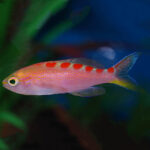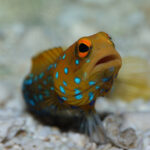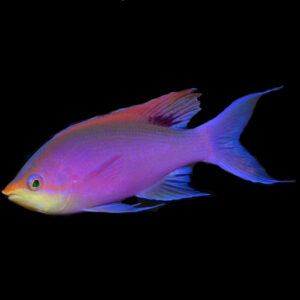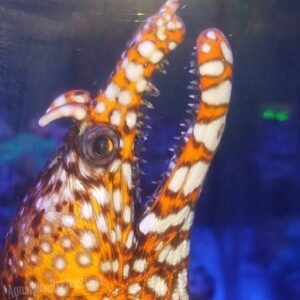Description
The Royal Gramma, Gramma loreto, is a beautiful and colourful fish with a maximum size of about 3 inches (7.6 cm). Its body is purple on the front half and bright yellow on the back half. The fins are yellow or orange with purple or blue edges.
Natural Habitat:
The Royal Gramma is found in the warm waters of the western Atlantic Ocean, from the Caribbean Sea to the coast of Brazil. It inhabits coral reefs, where it can be found hiding in crevices or caves.
Keeping Royal Gramma healthy, care level and difficulty:
The Royal Gramma is considered a moderately difficult fish to care for, as it requires specific water conditions and a well-established aquarium. The water temperature should be between 72 and 82 °F (22 and 28 °C), with a pH range of 8.1-8.4 and a specific gravity of 1.020-1.025. They are also sensitive to high levels of nitrates and other pollutants, so regular water changes are necessary to maintain good water quality.
Special requirements and feeding:
Royal Grammas are carnivores and should be fed a varied diet of high-quality meaty foods, such as mysis shrimp, brine shrimp, and small pieces of fish or squid. They should be fed twice a day, with only the amount they can eat in a few minutes. It’s important to provide them with a varied diet, as they may become picky eaters if only fed one type of food.
How Many Should I Keep:
Royal Grammas are peaceful and can be kept in pairs or small groups, as long as the aquarium is large enough to accommodate multiple fish. A 30-gallon (113.6 L) tank is recommended for a single fish, with an additional 10 gallons (37.8 L) of tank space for each additional fish.
Lighting Preference:
The Royal Gramma does not have any specific lighting requirements and can be kept under a variety of lighting conditions. However, they tend to be more vibrant and display their colours better under moderate to high lighting.
Suitable tank mates:
Royal Grammas are generally peaceful and can be kept with other non-aggressive fish, as long as they are not too small to be mistaken for prey. Good tank mates include other reef fish, such as clownfish, gobies, and blennies. They should not be kept with aggressive fish or with other fish that occupy the same niche in the aquarium.
Breeding Royal Gramma:
Breeding Royal Gramma in a home aquarium can be challenging due to their natural behaviour, but it is possible with proper preparation and patience. The following information can serve as a general guide for breeding Royal Gramma, but it’s important to note that success can vary depending on the individual fish and their environment.
- Breeding Setup:
To prepare for breeding, it is recommended to set up a separate breeding tank with a small territory for the pair of Royal Gramma to occupy. The breeding tank should have plenty of hiding places, such as rocks or caves, to mimic their natural environment. The water temperature should be between 76-80°F (24-27°C) and the pH should be 8.1-8.4. The salinity should be maintained at a level of 1.023-1.025 specific gravity.
- Pairing:
It is important to introduce a male and female Royal Gramma that have already formed a bond. This can be done by purchasing a bonded pair or observing fish in a display tank that are exhibiting courting behaviour. Once a suitable pair is identified, they should be transferred to the breeding tank together.
- Spawning:
Once the pair has established a territory, the female will lay her eggs on a flat surface, such as a rock or spawning slate. The male will then fertilize the eggs by releasing sperm over the eggs. After spawning, it is important to remove the adults from the breeding tank to prevent them from eating the eggs.
- Egg Development:
The eggs will typically hatch in 3-4 days, at which point they will become free-swimming fry. The fry should be fed small live foods, such as rotifers or newly hatched brine shrimp, multiple times a day. It’s important to ensure the water quality remains high and stable throughout the development process to ensure the best chances of survival for the fry.
- Juvenile Care:
As the fry grow, they can be gradually weaned onto commercial fish foods, such as small pellets or flakes. It is important to provide adequate hiding places and space for the growing juveniles. Once they reach a suitable size, typically around 1 inch (2.5 cm), they can be gradually introduced into a larger display tank with caution.
Breeding Royal Gramma can be a rewarding experience for experienced hobbyists who are willing to put in the effort and time to create a suitable environment for their fish. It is important to note that success can vary, and it may take several attempts before a successful breeding is achieved.
Sexual Dimorphism:
There is no significant difference in appearance between male and female Royal Grammas.
Distribution:
The Royal Gramma is found in the western Atlantic Ocean, from the Caribbean Sea to the coast of Brazil. While captive-bred specimens are available in the aquarium trade, the majority of specimens are wild-caught.
Summary:
The Royal Gramma is a beautiful and colourful fish that requires specific water conditions and a well-established aquarium. They are carnivorous and should be fed a varied diet of high-quality meaty foods. They can be kept in pairs or small groups with other peaceful reef fish and do not have any specific lighting requirements. While captive-bred specimens are available, the majority of Royal Grammas in the aquarium trade are wild-caught.
The Fish pictured here are representative only and the livestock you receive may vary in pattern, coloration, and shape.








